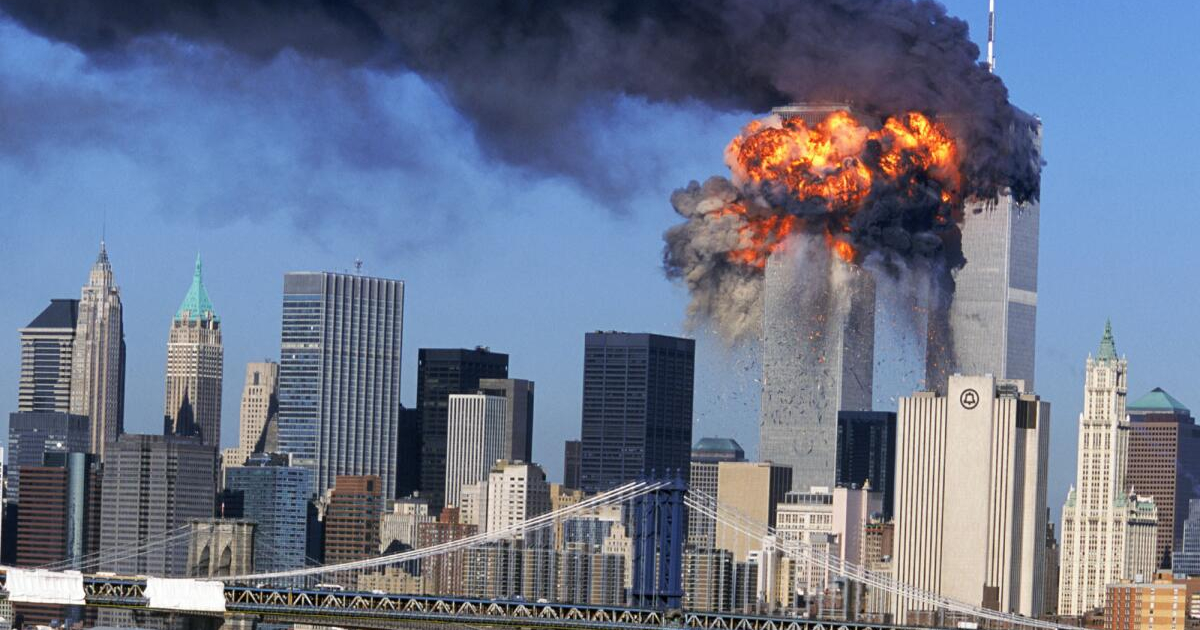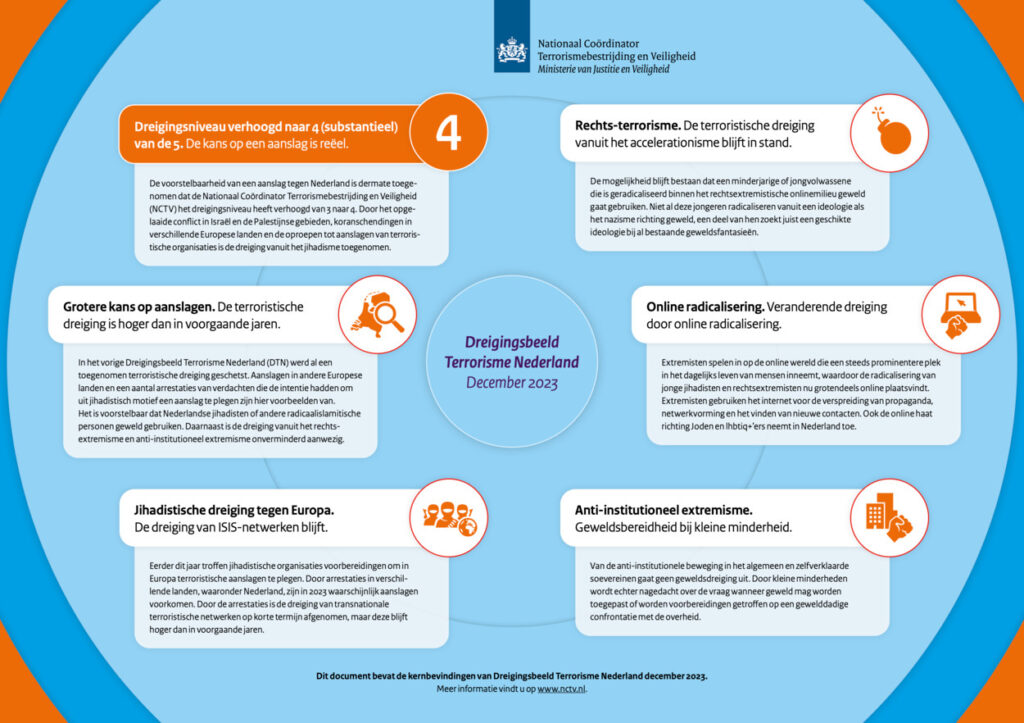Language:

What is terrorism?
Terrorism is a complex and often controversial subject, with varying perspectives on what qualifies as terrorism. What may be seen as a terrorist act by one party can be viewed as a legitimate fight for freedom by another. For example, resistance groups during World War II were considered terrorists by the occupying forces, but many saw them as freedom fighters. In modern times, terrorism is a nearly constant presence in daily news. Whether you open a newspaper or check a news app, there is almost always something related to terrorism. To gain a clear understanding of this pervasive phenomenon, this blog will examine legal definitions and official perspectives.
Definitions of terrorism according to official agencies
Below are the definitions provided by Dutch institutions responsible for addressing terrorism in the Netherlands, as well as what the law states:
- The National Coordinator for Security and Counterterrorism (NCTV) defines terrorism as: “The threat of, preparation for, or commission of severe violence directed at human lives for ideological motives, or acts aimed at causing society-disrupting property damage, with the goal of effecting societal change, instilling severe fear in the population, or influencing political decision-making.“
- The General Intelligence and Security Service (AIVD) describes terrorism as: “The ideologically motivated (preparation for the) commission of violence directed at human lives or the causing of society-disrupting damage, with the aim of instilling severe fear in (a part of) the population, bringing about societal change, and/or influencing political decision-making.“
- In the Dutch Penal Code, terrorism is defined as the commission of crimes “with a terrorist intent,” meaning: “The intent to instill severe fear in the population or a portion of the population of a country, or to unlawfully compel a government or international organization to act, refrain from acting, or tolerate something, or to seriously disrupt or destroy the fundamental political, constitutional, economic, or social structures of a country or international organization.“
As you can see, each of the definitions above differs, making the prosecution of terrorism a highly complex matter. There are also various international definitions, complicating matters further. Although there is international cooperation, these differences can sometimes make collaboration more challenging.
Characteristics of terrorist acts
When discussing the characteristics of terrorism, we refer to the specific traits or elements that are commonly present in terrorist activities. These characteristics help in identifying terrorist acts and distinguishing them from other forms of violence or criminal behavior. Understanding these traits is crucial for both preventing and combating terrorism.
Despite the different definitions used by agencies and countries, several common characteristics of terrorist acts can be identified:
- Ideological motives: Terrorists often act based on a specific ideology or belief.
- Spreading fear: The primary goal is often to spread fear among the population.
- Political goals: Terrorists usually aim to achieve political change or influence.
- Violence or the threat of violence: Terrorist actions often involve violence or the threat of violence.
- Targeting civilians or non-military targets: Innocent civilians are often the intended victims.
Different forms of terrorism
Terrorism manifests in various forms, each with its own characteristics, objectives, and methods. These different forms reflect the diverse ideologies, motivations, and contexts in which terrorist activities take place. Understanding these variations is crucial for effective prevention, combatting, and analysis of terrorist threats. Below is an overview of the most common forms of terrorism:
- Religiously inspired terrorism: This form is based on religious beliefs and interpretations. Followers often believe they are acting on a divine mandate. Examples include jihadist groups such as Al-Qaeda and ISIS, as well as extremist splinter groups of other religions.
- Right-wing extremist terrorism: This type is based on far-right ideologies, often characterized by nationalism, racism, and xenophobia. It typically targets minorities, immigrants, or political opponents.
- Left-wing extremist terrorism: Based on far-left ideologies, such as radical communism or anarchism, this form often targets capitalist symbols, government institutions, or what is seen as the “establishment.”
- Ethno-nationalist terrorism: This type is aimed at achieving independence or autonomy for a specific ethnic group or region. Examples include ETA in Spain or the IRA in Northern Ireland.
- Single-issue terrorism: This form focuses on one specific issue, such as animal rights or environmental protection. Proponents use terrorist tactics to draw attention to their cause and force change.
Each of these forms has its own characteristics and requires a specific approach to combat it. It is important to note that these categories are not always strictly separated and that overlap can exist between different forms of terrorism.
The current terrorist threat in the Netherlands
The Terrorist Threat Assessment for the Netherlands (DTN) is a periodic analysis of the terrorist threat in the Netherlands, compiled by the National Coordinator for Security and Counterterrorism (NCTV). This analysis is conducted and published four times a year.
The DTN uses a system with five threat levels:
- Minimal: No threat present.
- Limited: The threat is minor but not absent.
- Significant: A terrorist attack in the Netherlands is conceivable.
- Substantial: There is a real chance of an attack in the Netherlands.
- Critical: There are concrete indications that an attack is imminent in the Netherlands.

The Netherlands is currently at level 4 (substantial) of the DTN. This means the likelihood of an attack is considered real. The NCTV has identified several movements that currently pose a threat:
- Jihadist terrorism: This remains the primary terrorist threat against the Netherlands. Followers are fueled by propaganda that includes imagery of international conflicts and religious provocations.
- Right-wing extremism: Although the groups are small, there is growing online outreach and increasing international cooperation.
- Anti-institutional extremism: A small portion of this movement shows a willingness to commit violence against government institutions and politicians.
These threats are evolving within a complex international context and are being amplified by online radicalization and propaganda. The situation requires constant vigilance from security services and society as a whole.
How can I assist you?
As a Radicalization and Terrorism Expert (RTE), I offer valuable support and advice to individuals and organizations seeking to prepare for the challenges of radicalization and terrorism. Whether you need training, workshops, or strategic advice, I am happy to help you gain insight into these complex topics and how to effectively address them. Feel free to contact me through my contact page for more information or to schedule a consultation. Together, we can work toward a safer and more resilient environment.
